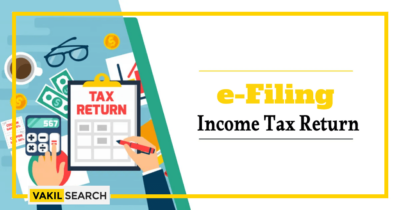In this article, you will learn about the process of Income Tax and how it works in India.
Income Tax alludes to a level of your pay that you need to pay to the government in the rule. The Government involves the money gathered by this immediate duty course for infrastructural improvements and to pay the workers of focal and state government bodies.
Taxes are for the most of two sorts, direct tax and Indirect type assessments. A charge imposed straightforwardly on the pay procured is called a direct tax, for instance, income tax. The tax estimation depends on the pay section rates relevant during that monetary year.
Navigate the Realm of Financial Success Seamlessly With Our Cutting-Edge Online Accounting Services in India, Empowering Your Business for Growth in the Digital Age!
Types of Taxpayers
The Income-tax Act has grouped the kinds of citizens in classifications to apply different tax rates for various citizens.
Citizens are divided into the below-mentioned categories:
- Individuals
- Hindu Undivided Family
- Association of Persons
- Body of Individuals
- Firms
- Organizations
Further, Individuals are extensively ordered into occupants and non-residents. Resident people are obligated to pay tax on their worldwide pay in India, for example, income procured in India and abroad. The people who qualify as non-residents might arise to pay income acquired or gathered in India. The resident status must be resolved independently for tax purposes for each monetary year based on the singular tenor of stay in India.
Resident Individuals are additionally grouped into underneath referenced classes for charge purposes-
- People under 60 years old
- People matured more than 60 yet under 80 years
- People matured over 80 years
What Are the Various Taxable Categories of Income?
Income taxes are imposed relying upon the kind of revenue. Following are the five principal pay heads from which taxes are deducted.
Use the Income Tax calculator on Vakilsearch to quickly calculate your taxes and submit your ITR.
- Salaried Income
Income that all employees get from their managers is ordered under this head as they are taxable. According to section 192 of the Income Tax Act, the business will keep taxes if the workers don’t go in close vicinity to the available section. About deduction of taxes and the net paid pay are itemized in Form 16 that the recruiter should give to the employee.
- Profit from Capital Gains
The tax assesses earnings from the capital assets’ sale are subject to capital gains taxation. Buildings, lands, securities, equity markets, debt instruments, and jewelry are examples of capital assets. When such properties are sold, taxes are levied on the assessed income.
- House Property Income
Tax is charged on house property if the owner rents it out. However, the property cannot be used for commercial or professional purposes under this heading.
- Business income (profits)
Profits earned from businesses or professional services are taxable at the applicable rates under sections 30 to 43D of the 80d Income Tax. This income category is also known as “Profits and Gains of Business or Profession.”
- Other Sources of Income
This category includes income from sources other than the points listed above
The following are some examples of specific income falling under this category:
- Lottery/horse race profits
- Dividend earnings Pension received following the death of the pensioner
- Rental earnings (other than house properties)
- Received gifts
- Government financial assets, debt instruments, and securities
Tax Slabs for Tax Payers
Under Indian income tax laws, every one of these taxpayers is taxed differently. Individual, HUF, AOP, and BOI taxpayers are taxed based on their income slab, whereas firms and Indian companies have a fixed rate of tax calculated on their taxable profits. People’s earnings are classified into tax brackets or Sales Tax Return filing. And the tax rate varies by tax slab. The rate at which income is taxed rises in direct proportion to income. Individuals and HUF taxpayers were given a ‘New tax regime’ in Budget 2020
Existing / Old Income Tax Regime
The old tax system gives three slab rates to demand Income tax which are 5%, 20% assessment rate and 30% for various sections of the income. The people have been given a choice to go on with this Old expense system, and they can guarantee derivations of remittances like Leave Travel Concession (LTC), House Rent Allowance (HRA), and certain different recompenses. Furthermore, allowances for charge-saving speculations according to area 80C (LIC, PPF, NPS and so on) to ITR 4 filing can be asserted. Standard derivation of Rs 50,000, allowance for interest paid on home credit.
Individual taxpayers under the age of 60 are subject to the following tax slab rates under the old tax regime:
| Income Range | Tax rate | Tax to be paid |
| Up to ₹.2,50,000 per year | 0 | No tax |
| Ranging between ₹2.5 lakhs and ₹5 lakhs | 5% | 5% of your income |
| Ranging between ₹5 lakhs and ₹10 lakhs | 20% | ₹12,500+ 20% of income above ₹5 lakhs |
| Above ₹10 lakhs | 30% | ₹1,12,500+ 30% of income above ₹10 lakhs |
There are two additional tax brackets for people over the age of 60 and those over the age of 80. A word of caution: Many people believe that if they earn ₹12 lakhs, they must pay 30% tax on that amount, that is ₹3,60,000. That is not correct. In the progressive tax system, a person earning 12 lakhs will pay ₹1,12,500+ ₹60,000 = ₹1,72,500.
Income Tax Slabs in the New Tax Regime
From the FY 2020-21, another assessment system is accessible for people and HUFs with lower tax rates and zero allowances/exclusions. People and HUF have the choice to pick the new system or go on with the old regime. The new assessment system is discretionary, and the decision ought to be made at the hour of recording the ITR 5 form. On the off chance that the old system is continued then every one of the allowances/exclusions as accessible can be profited by the citizen.
The income tax slab under the new duty system are:
| New regime slab rates | Existing regime slab rates | ||
| Income from ₹2.5 lakh to ₹5 lakh | 5% | Income from Rs 2.5 lakh to Rs 5 lakh | 5% |
| Income from ₹5 lakh to ₹7.5 lakh | 10% | Income from ₹5 lakh to ₹10 lakh | 20% |
| Income from ₹7.5 lakh to ₹10 lakh | 15% | Income above ₹10 lakh | 30% |
| Income from ₹10 lakh to ₹12.5 lakh | 20% | ||
| Income from ₹12.5 lakh to ₹15 lakh | 25% | ||
| Income above ₹15 lakh | 30% | ||
Most tax breaks and exclusions are no longer available if taxpayers choose the New Tax regime. However, the following exemptions and deductions are available under the new regime:
- Allowances for transportation in the case of a disabled person.
- Transportation allowance received to cover transportation costs incurred as part of the job.
- Any remuneration received to cover the cost of a tour or transfer.
- Daily allowance received to cover ordinary regular charges or expenses incurred due to his nonattendance from his regular place of work.
Conclusion
This article explains the income tax slabs: https://www.incometaxindia.gov.in/Pages/Deposit_TDS_TCS.aspx and the various heads under which an individual is liable to pay income tax. Apart from that, we have also discussed the old and the new income tax regime. However, per the latest budget, 2022 following are the changes:
Read more,










